Current status of the Koishiwaragawa Dam Construction Project
- Overcoming natural disaster and implementation of new technologies -
6 June, 2018
Japan Water Agency (=JWA) has been engaged in the Koishiwaragawa Dam construction project in Kyushu region. This multipurpose dam in the Koishiwarawa River in the Chikugo River System will be used for flood control, maintenance of normal function of river, and supply of domestic water. In addition, the construction of the water conveyance facilities approximately 5 km in length toward the downstream of the dam is included in this project.
We would like to introduce the current status of the project, which is at a peak period of dam construction, and also new technologies implemented in this project.
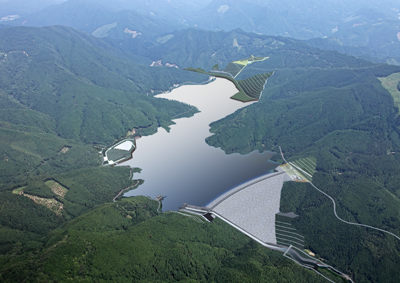
Rendering - Koishiwaragawa Dam
I. Current Status of the Koishiwaragawa Dam Construction Project
1.Construction of the dam body
Koishiwaragawa Dam is
a rock fill dam and its construction works of the dam body started in April 2016, and foundation excavation
started in August 2016. When preparation and foundation treatment were proceeding towards the start of dam construction,
Kyushu region was hit by a horrible storm disaster in July 2017.
As for the dam body, as its foundation excavation had been almost finished, the machinery such as boring machines which were installed in the lower part of construction site were submerged by freshet. In addition, the temporarily placed equipment around there, and the construction yards were also damaged or wished away. There were also some facilities that suffered damage, and forced to take a long period of time to be restored such as the construction yard located in the upstream area and the muck disposal yard.
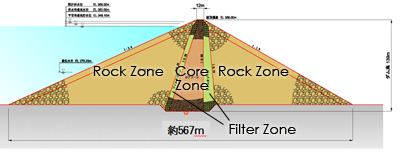
Cross sectional view of Koishiwaragawa Dam
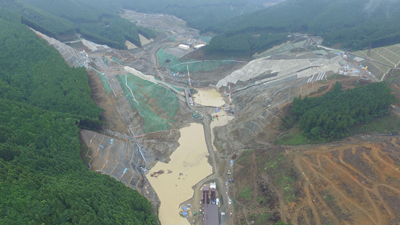
Aerial image of the inundated dam site taken by UAV
(8 July 2017)
(Photo: Kajima Corporation/Takenaka Civil Engineering & Construction/Sumitomo Mitsui Construction JV)
The restoration work after the disaster started by draining the water in the dam. As power poles collapsed in the downstream area, and then electricity supply was cut off, JWA strove to work through night and day by using generators on the site, and resumed the foundation treatment work about 10 days after the disaster.
After that, JWA continued the restoration work while proceeding the ongoing main construction work as well. JWA started filling of the rock zone in August - the following month of the disaster, placing concrete for fixing the discharge facility (spillway) in September, and then filling of the core zone (cut-off water zone for sealing water) which can be the heart of the dam in October. At the end of January, the height of the filling (core zone) reached approx. 20m in height, and both the concrete placement at the intake facilities and the discharge facilities were done in parallel.
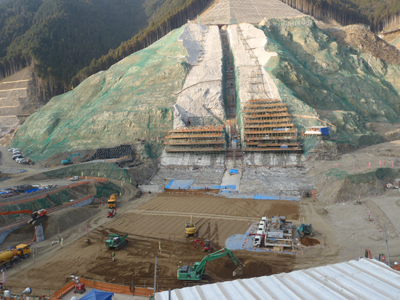
Construction (core zone of the dam body) December 2017
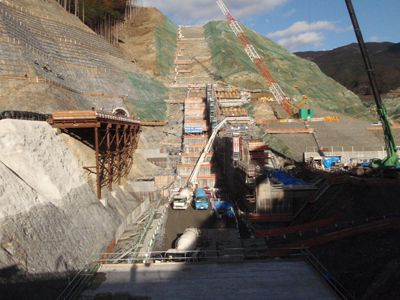
Concrete placement (spillway) December 2017
2.Construction of the water conveyance facility
JWA undertook a construction work of the water conveyance facility in July 2015 and began excavation of a headrace tunnel by using a shield machine from the outlet side (Koishiwara River, Egawa District) in September 2016, and then the intake side (Sada River, Kiwada District) in April 2017. Although the excavation work proceeded as planned at first, Kyushu region was hit by a horrible torrential rainfall in July 2017, and the construction site was seriously damaged. As for the intake side, in particular, the shield machine was submerged and damaged by a large amount of sediment and driftwood. To make matters worse, the bank protection which was nearly completed was buried with sediment and driftwood. On the other hand, damage of the outlet side was minor, but the shield machine was submerged and damaged due to shutdown of the pumping equipment after the power failure and it took about two months to resume excavation.
After that, JWA resumed excavation from the outlet side, and it has extended over 50% of the total length (2,538 m out of 5,040 m) in January 2018. On the intake side into which a large amount of sediment flowed, removal of sediment covered the bank protection was completed, but still the shield machine is under repair, and JWA is preparing for resumption of excavation in the summer of 2018.
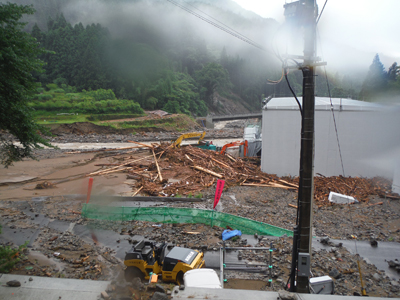
Intake of the water conveyance facility, 11 July 2017
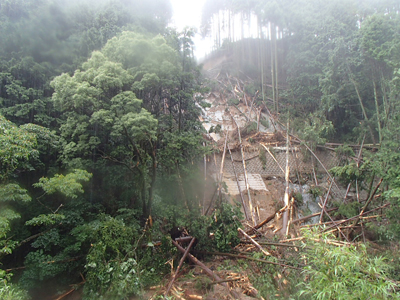
Road to the construction site (Left bank side of Egawa Dam reservoir), 8 July 2017
3.Road relocation
About 80% of relocation of national and forestry roads in consequence of the dam construction had been completed or near completion, but construction machines and construction roads were damaged and destroyed by the disaster. Because the road construction needs to be carried out from one side after another, it took about two months to be fully restored, so all the construction works resumed in September 2017.
The construction plan for some of the roads to be relocated was reviewed, and is obliged to be revised due to the damage of the roads for the construction. At present, all the roads in all the sections, including additional ones, are in progress before completion of the project.
Finally
The Koishiwaragawa Dam Construction Project is now at the peak period of dam construction. JWA has been proceeding with an enormous amount of work including not only that of the dam body, spillway, inspection gallery, water intake tower, or foundation treatment, but also that of water conveyance facility, and road relocation in such a short period of time, which JWA has never experienced in past. JWA accumulates and then utilize vast amount of information collected on the stage of design and construction in order to improve the efficiency of construction supervision while executing the ongoing project, taking advantages of new technologies. Furthermore, JWA aims to manage facilities in sophisticated and efficient manners in the future by making the most of the information. The staff of JWA, contractors, cooperative companies and local municipalities are working together and doing our best until the project is completed, while making every possible effort to shorten the construction period and conserve the environment.
Finally, we wish to express our heartfelt sympathy to everyone who suffered from the heavy rain in the northern part of Kyushu, and we would like to ask many of you concerned for your continued understanding, support and cooperation.
Report by: Asakura Management and Construction Office, Japan Water Agency
Translation by: International Affairs Division, The Japan Water Agency
- ICT: Information and Communication Technology
- ICT is a technology that aims to streamline construction by utilizing information communication technology to efficiently utilize various information.
- BIM/CIM: Building Information Modeling/Construction Information Modeling/Management
- BIM/CIM aims to construct an efficient and high quality construction and production system by utilizing the latest ICT technology, and sharing information on the stage of planning, design, construction and management.







